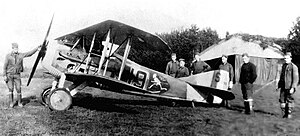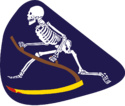13th Aero Squadron: Difference between revisions
edited aces |
edited introduction |
||
| Line 68: | Line 68: | ||
}} |
}} |
||
The '''13th Aero Squadron''' was a [[Air Service, United States Army]] unit that fought on the [[Western Front]] during [[World War I]]. After the [[1918 Armistice with Germany]], the squadron returned to the United States in March 1919 and demobilized. <ref name="Gorrell"> Series "E", Volume 9, History of the 11th-13th Aero Squadrons. Gorrell's History of the American Expeditionary Forces Air Service, 1917–1919, National Archives, Washington, D.C.</ref> <ref name="OOB">Order of Battle of the United States Land Forces in the First World War, Volume 3, Part 3, Center of Military History, United States Army, 1949 (1988 Reprint)</ref> |
The '''13th Aero Squadron''' was a [[Air Service, United States Army]] unit that fought on the [[Western Front]] during [[World War I]]. |
||
The squadron was assigned as a Day Pursuit (Fighter) Squadron as part of the [[2d Pursuit Group]], [[First United States Army]]. Its mission was to engage and clear enemy aircraft from the skies and provide escort to reconnaissance and bombardment squadrons over enemy territory. It also attacked enemy observation balloons, and perform close air support and tactical bombing attacks of enemy forces along the front lines. After the [[1918 Armistice with Germany]], the squadron returned to the United States in March 1919 and demobilized. <ref name="Gorrell"> Series "E", Volume 9, History of the 11th-13th Aero Squadrons. Gorrell's History of the American Expeditionary Forces Air Service, 1917–1919, National Archives, Washington, D.C.</ref> <ref name="OOB">Order of Battle of the United States Land Forces in the First World War, Volume 3, Part 3, Center of Military History, United States Army, 1949 (1988 Reprint)</ref> |
|||
On 16 October 1936 the squadron was re-constituted, and consolidated with the [[United States Army Air Corps]] 13th Attack Squadron. Today, the current [[United States Air Force]] unit which holds its lineage and history is the [[13th Bomb Squadron]], assigned to the [[509th Operations Group]], [[Whiteman Air Force Base]], Missouri.<ref name="Rogers">Rogers, Brian. United States Air Force Unit Designations Since 1978. Hinkley, England: Midland Publications, 2005. ISBN 1-85780-197-0.</ref> |
On 16 October 1936 the squadron was re-constituted, and consolidated with the [[United States Army Air Corps]] 13th Attack Squadron. Today, the current [[United States Air Force]] unit which holds its lineage and history is the [[13th Bomb Squadron]], assigned to the [[509th Operations Group]], [[Whiteman Air Force Base]], Missouri.<ref name="Rogers">Rogers, Brian. United States Air Force Unit Designations Since 1978. Hinkley, England: Midland Publications, 2005. ISBN 1-85780-197-0.</ref> |
||
Revision as of 15:59, 27 August 2013
| 13th Aero Squadron | |
|---|---|
 13th Aero Squadron - SPAD XIII assigned to Major Charles Biddle, likely taken at Souilly Airdrome, France, 1918 | |
| Active | 14 June 1917-29 March 1919 |
| Country | |
| Branch | |
| Type | Squadron |
| Role | Pursuit |
| Part of | American Expeditionary Forces (AEF) |
| Fuselage Code | "Grim Reapers" [1] |
| Engagements | World War I |
| Commanders | |
| Notable commanders | Captain (later Major) Charles J. Biddle[1] Lt. Dickinson Este[2] |
| Insignia | |
| 13th Aero Squadron Emblem |  |
| Aircraft flown | |
| Fighter | SPAD XIII, 1918[3] [4] |
| Trainer | Curtiss JN-4, 1917[3] [4] |
| Service record | |
|---|---|
| Operations |
2d Pursuit Group Western Front, France: 28 June-11 November 1918[5] |
| Victories |
29 Aircraft
|
The 13th Aero Squadron was a Air Service, United States Army unit that fought on the Western Front during World War I.
The squadron was assigned as a Day Pursuit (Fighter) Squadron as part of the 2d Pursuit Group, First United States Army. Its mission was to engage and clear enemy aircraft from the skies and provide escort to reconnaissance and bombardment squadrons over enemy territory. It also attacked enemy observation balloons, and perform close air support and tactical bombing attacks of enemy forces along the front lines. After the 1918 Armistice with Germany, the squadron returned to the United States in March 1919 and demobilized. [4] [7]
On 16 October 1936 the squadron was re-constituted, and consolidated with the United States Army Air Corps 13th Attack Squadron. Today, the current United States Air Force unit which holds its lineage and history is the 13th Bomb Squadron, assigned to the 509th Operations Group, Whiteman Air Force Base, Missouri.[8]
History
Origins
The 13th Aero Squadron was organised at Kelly Field, Texas on 14 June 1917. After a short period of organization, which included "snake-chasing and cactus-cutting", the squadron was moved to Wilbur Wright Field, Ohio in the beginning of July where its aviation cadets began flight training on the Curtiss JN-4 Jenny trainer. Training in Ohio lasted until 1 November when it received orders for overseas duty. The squadron proceeded to the Aviation Concentration Center, Garden City, New York, where it awaited transport to Europe. At the end of November, the squadron moved to Philadelphia, where it boarded the SS Northland, and departed the United States on 4 December. The ship arrived at Liverpool, England on 25 December where the same day, they boarded a train for Winchester, England where they were temporarily assigned to a Rest Camp. After a cross-channel crossing from Southampton to Le Harve, France, the squadron boarded a French train south, arriving at the St. Maixent Replacement Barracks, 1 Jan 1918. [4] [9]
At St. Maixent the squadron waited for several weeks and largely performed construction and other activities designed to improve the newly-established base. At the end of January, orders were received to proceed to the 3d Air Instructional Center at Issoudun Aerodrome for advanced flight and air combat training. For the next four months the squadron trained at Issodun, with detachments sent to French Air Force gunnery ranges at Meucon and Haussimont Aerodromes. Finally, in the beginning of June, training was completed and the squadron moved to the 1st Air Depot at Colombey-les-Belles Airdrome where the 13th Aero Squadron was classified as a Pursuit Squadron and received French SPAD XIII aircraft. Once equipped the squadron was ordered to Gengault Aerodrome, near Toul, in the "Zone of Advance". There the 13th received its combat assignment to the 2d Pursuit Group where it joined the 22d, 49th and 139th Aero Squadrons. [4] [9]
Combat in France

The 13th was charged with protection of the St. Mihiel sector, and its pilots soon were active in intercepting and attacking enemy aircraft that attempted reconnaissance over Allied lines. The Spads also escorted Allied observation planes deep into enemy territory where their pilots sometimes engaged enemy planes and attacked hostile balloons. [4] [9]
While participating in the St. Mihiel Offensive, which was undertaken to reopen the Paris-Nancy railroad in the vicinity of Commercy, the 13th fought with vigor. While ground forces were attacking and destroying, men, material, and morale, the 13th's pilots kept busy destroying enemy aircraft and balloons, and making the sky safe for Allied observation planes. [4] [9]
The 13th claimed several "aces" from this period of its history: Charles J Biddle, Murray K Guthrie, Frank K Hays, John J Seerly, and William H Stovall. Major Carl Spaatz, although on orders to return home, sought and received permission to serve with the 13th Aero Squadron as a pursuit pilot. He subordinated himself to men of lower rank, but as a result of his ardent zeal and ability, he was soon a flight leader and was credited with destroying two Fokkers during the St. Mihiel and Meuse-Argonne Offensive. [4] [9]
The Meuse-Argonne campaign was launched on 26 September 1918 to reduce the St. Mihiel salient. The 13th Aero Squadron moved on 23 September to Belrain Aerodrome, and from there inflicted heavy losses upon enemy aircraft and balloons. As its pilots gained domination of the air, their responsibilities were expanded to include protection of ground forces, strafing of enemy troops and bombing of targets that could be observed within enemy lines. [4] [9]
On 7 November, the squadron moved to Souilly Aerodrome and continued combat operations until the Armistice with Germany was signed and combat ended on 11 November 1918. [4] [9]
Demobilization

After the armistice, the squadron remained at Souilly until 16 December 1918 when orders were received from First Army for the squadron to report to the 1st Air Depot, Colombey-les-Belles Airdrome to turn in all of its supplies and equipment and was relieved from duty with the AEF. The squadron's planes were delivered to the Air Service Production Center No. 2. at Romorantin Aerodrome, and there, practically all of the pilots and observers were detached from the Squadron.[10]
Personnel were subsequently assigned to the Commanding General, Services of Supply and ordered to report to the staging camp at Le Mans, France. There, personnel awaited scheduling to report to one of the Base Ports in France for transport to the United States and subsequent demobilization.[10] From 6 February to 3 March 1919, the squadron was at the port of Brest before crossing the Atlantic aboard the SS America. From 13-29 March 1919 the squadron was at Mitchell Field, New York, where it was demobilized. It remained inactive until it was reconstituted in 1936. [4] [9]
Lineage
- Organized as 13th Aero Squadron on 14 June 1917
- Re-designated: 13th Aero Squadron (Pursuit), on 28 June 1918
- Demobilized on 29 March 1919.[3]
Assignments
|
|
Stations
|
|
Combat sectors and campaigns
| Streamer | Sector/Campaign | Dates | Notes |
|---|---|---|---|
| Toul Sector | 10 August-11 September 1918 | [11] | |
| St. Mihiel Offensive Campaign | 12-16 September 1918 | [11] | |
| Verdun Sector | 17-22 September 1918 | [11] | |
| Meuse-Argonne Offensive Campaign | 26 September-11 November 1918 | [11] |
References
![]() This article incorporates public domain material from the Air Force Historical Research Agency
This article incorporates public domain material from the Air Force Historical Research Agency
- ^ a b c Over the Front: A Complete Record of the Fighter Aces and Units of the United States and French Air Services, 1914–1918 Norman Franks, Frank W. Bailey. Grub Street, 1992. ISBN 0-948817-54-2, ISBN 978-0-948817-54-0.
- ^ AFHRA 13th Bomb Squadron History
- ^ a b c d e Mauer, Mauer (1969), Combat Squadrons of the Air Force, World War II, Air Force Historical Studies Office, Maxwell AFB, Alabama. ISBN 0-89201-097-5
- ^ a b c d e f g h i j k l m Series "E", Volume 9, History of the 11th-13th Aero Squadrons. Gorrell's History of the American Expeditionary Forces Air Service, 1917–1919, National Archives, Washington, D.C.
- ^ Series "H", Section "O", Volume 29, Weekly Statistical Reports of Air Service Activities, October 1918-May 1919. Gorrell's History of the American Expeditionary Forces Air Service, 1917–1919, National Archives, Washington, D.C.
- ^ 13th Aero Squadron@www.theaerodrome.com
- ^ Order of Battle of the United States Land Forces in the First World War, Volume 3, Part 3, Center of Military History, United States Army, 1949 (1988 Reprint)
- ^ Rogers, Brian. United States Air Force Unit Designations Since 1978. Hinkley, England: Midland Publications, 2005. ISBN 1-85780-197-0.
- ^ a b c d e f g h 13th Bomb Squadron History
- ^ a b Series "D", Weekly Statistical Reports of Air Service Activities, October 1918-May 1919. Gorrell's History of the American Expeditionary Forces Air Service, 1917–1919, National Archives, Washington, D.C.
- ^ a b c d United States War Department (1920), Battle Participation of Organizations of the American Expeditionary Forces in France, Belgium and Italy, 1917–1919, Washington, Government Printing Office, 1920

